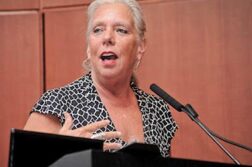 DONALD CRIMP was an AIDS activist, an art critic, a critical thinker, a prolific writer with an expertise on Andy Warhol, and so much more. Crimp, who was called a “towering figure” with an international reputation, “could be found at a ballet, opera, concert, exhibition or some combination of these nearly every day” of his life, in the words of the obituary published in The New York Times. He died of multiple myeloma at his New York City home on July 5, 2019, at the age of 74.
DONALD CRIMP was an AIDS activist, an art critic, a critical thinker, a prolific writer with an expertise on Andy Warhol, and so much more. Crimp, who was called a “towering figure” with an international reputation, “could be found at a ballet, opera, concert, exhibition or some combination of these nearly every day” of his life, in the words of the obituary published in The New York Times. He died of multiple myeloma at his New York City home on July 5, 2019, at the age of 74.
Born and raised in Coeur d’Alene, Idaho, he described growing up in an “incredibly conformist culture” in a lengthy interview with Sarah Schulman, conducted for the ACT UP Oral History Project. His youthful decision to become an architect led to a scholarship at Tulane University, in New Orleans, in 1962, but he quickly switched his major to art history. He began going to bars—not necessarily gay bars, but sailor bars, where he hung out with faculty members and assorted drag queens, prostitutes, and sailors, and he began to read gay literature. Jean Genet was a particular favorite.
Thanks to some lucky breaks, friendships, and deep knowledge of pre-Columbian art, he was hired by the Guggenheim in 1968, and several years later began to write for Art News. Movies—the more obscure, the better—consumed vast chunks of Crimp’s life at that time, and he attended hundreds of them with his first long-term boyfriend. He loved to dance, calling himself a “disco bunny.” In his 2016 memoir Before Pictures, he wrote about taking “way too many drugs during the late 1960s and 1970s” in order to derive the utmost pleasure from dance culture.
In 1977, he curated an exhibition titled Pictures at Artists Space, a small alternative gallery in Tribeca, in which painters and photographers made use of images appropriated from mass culture. “Pictures Generation” entered the vocabulary of art criticism, and in 2009 the Metropolitan Museum mounted an exhibit called Pictures Generation, 1974-1984.
Crimp insisted that art had to “engage with AIDS,” and as editor of the scholarly arts journal October, published by MIT Press, he put together a special issue titled “AIDS: Cultural Analysis/Cultural Activism ” in 1987 (the same year that ACT UP was founded). Considered a “wake-up call to the art world,” it became the best-selling issue in the journal’s history, and included personal stories of people who were HIV-positive as well as a glossary of terminology. The article that he wrote for the issue, titled “How to Have Promiscuity in an Epidemic,” has become a classic.
By the 1990s, he joined the Department of Art and Art History at the University of Rochester in Rochester, New York, and, always wanting to learn something new, he began to study poetry near the end of his life. He is survived by members of his biological family and his spouse, New York City-based artist Yoshiaki Mochizuki.
Martha E. Stone is the literary editor of this magazine.





